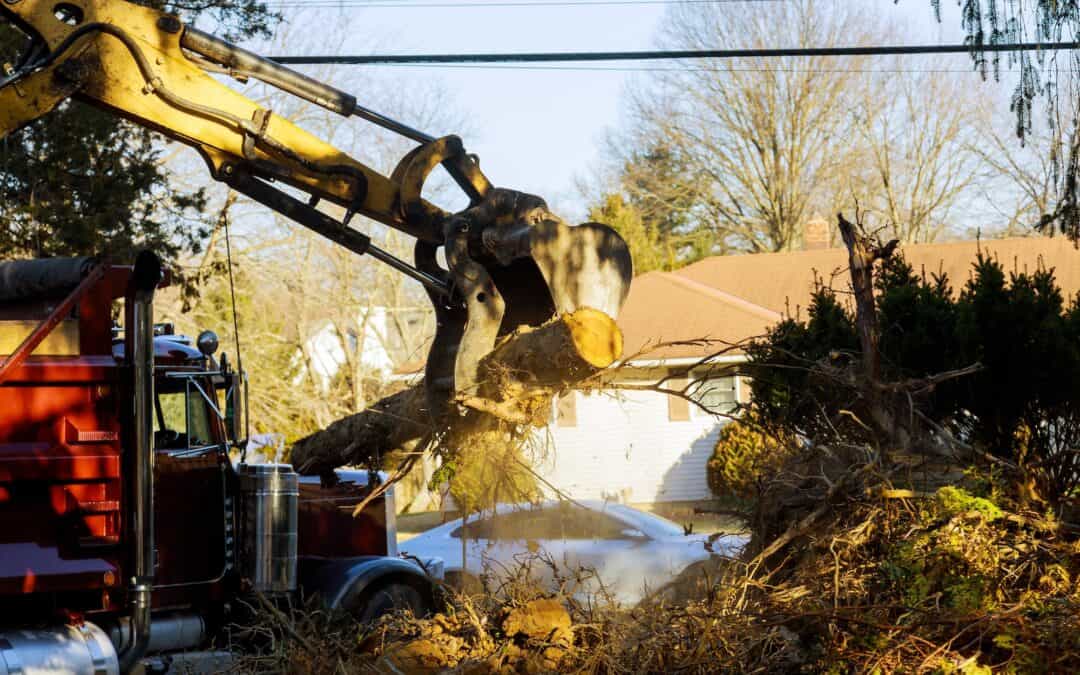When we think about tree removal, it’s essential to grasp the entire process involved. Tree removal is not merely about cutting down a tree; it encompasses a series of steps that ensure the task is completed safely and efficiently. Initially, we must assess the tree’s condition and its surroundings.
This evaluation helps us determine whether the tree poses a risk to nearby structures or if it is diseased or dying. We often start by examining the tree’s health, looking for signs of decay, pest infestations, or structural weaknesses. Once we have a clear understanding of the tree’s status, we can move forward with planning the removal.
This preparation includes clearing the area around the tree to create a safe working environment. We need to remove any obstacles that could hinder the process, such as nearby plants, furniture, or debris.
Additionally, we must consider the direction in which the tree will fall. By analyzing the tree’s lean and surrounding landscape, we can make informed decisions about how to proceed. The actual removal process typically involves cutting the tree down in sections, especially for larger trees, to minimize risks and ensure safety.
Each step requires careful planning and execution to avoid accidents and damage to surrounding property.
Key Takeaways
- Understanding the tree removal process is essential for a successful and safe removal of trees from your property.
- Factors to consider before tree removal include the size and health of the tree, as well as any potential impact on the surrounding environment.
- The best time of year for tree removal is typically during the dormant season, which is usually late fall or winter.
- Weather conditions play a crucial role in tree removal, as strong winds or heavy rain can make the process dangerous and difficult.
- Tree removal can have a significant impact on wildlife, so it’s important to consider the potential consequences and take necessary precautions.
Factors to Consider Before Tree Removal
Tree Health and Alternatives
One of the primary considerations is the health of the tree itself. If a tree is diseased or infested with pests, it may be necessary to remove it to prevent further spread to other trees in our yard or neighborhood. However, if the tree is healthy, we might want to explore alternatives such as pruning or treatment options.
Tree’s Role in the Landscape
Understanding the tree’s role in our landscape is crucial; it may provide shade, enhance property value, or contribute to local biodiversity.
Location and Legal Considerations
Another significant factor is the location of the tree. Trees situated close to buildings, power lines, or other structures pose a greater risk during removal. We must evaluate whether the tree’s proximity to these elements could lead to potential damage during the cutting process. Additionally, local regulations and ordinances may dictate whether we can remove certain trees, especially if they are protected species or part of a conservation area. Engaging with local authorities or consulting with professionals can help us navigate these legal considerations effectively.
The Best Time of Year for Tree Removal
Timing plays a critical role in the tree removal process. We often find that late fall and winter are considered the best seasons for removing trees. During these months, many trees enter a dormant phase, which means they have less sap flow and reduced leaf cover.
This dormancy not only makes the removal process easier but also minimizes stress on surrounding vegetation. Additionally, with fewer leaves on the trees, visibility improves, allowing us to assess the situation more accurately and plan accordingly. Conversely, removing trees in spring or summer can be more challenging due to increased sap flow and foliage.
The presence of leaves can obscure our view of potential hazards and complicate the cutting process. Moreover, removing trees during their active growth period can lead to more significant disturbances in the surrounding ecosystem. Therefore, by choosing the right time of year for tree removal, we can ensure a smoother operation while also being considerate of our environment.
Weather Conditions and Tree Removal
| City | Weather Conditions | Number of Trees Removed |
|---|---|---|
| New York | Snowy | 150 |
| Los Angeles | Windy | 80 |
| Chicago | Rainy | 200 |
| Miami | Hurricane | 300 |
Weather conditions significantly influence our decision-making when it comes to tree removal. Ideally, we want to conduct removals on clear days with minimal wind. High winds can create unpredictable situations, making it difficult to control the direction in which a tree falls.
Rainy conditions can also complicate matters by making the ground slippery and increasing the risk of accidents for those involved in the removal process. Therefore, we must monitor weather forecasts closely and choose a day that offers optimal conditions for safety. In addition to immediate weather conditions, we should also consider seasonal weather patterns.
For instance, if we are approaching a storm season, it may be wise to remove any trees that pose a risk before severe weather hits. Trees that are already weakened by disease or age may be more susceptible to falling during storms, potentially causing damage to our property or endangering lives. By being proactive and aware of weather patterns, we can make informed decisions about when to proceed with tree removal.
Impact of Tree Removal on Wildlife
One of the often-overlooked aspects of tree removal is its impact on local wildlife. Trees provide essential habitats for various species, including birds, insects, and small mammals. When we remove a tree, we must consider how this action affects these creatures and their ecosystems.
For instance, nesting birds may lose their homes during breeding season if we remove trees without proper timing and consideration. Therefore, it’s crucial for us to assess whether any wildlife is residing in or around the tree before proceeding with its removal. Moreover, we should think about how removing a tree might alter the local ecosystem.
Trees play a vital role in maintaining biodiversity by providing food sources and shelter for numerous species. If we remove a tree without considering its ecological significance, we may inadvertently disrupt local wildlife populations. To mitigate this impact, we can explore options such as relocating wildlife or planting new trees in different areas to replace those that have been removed.
Tree Removal and Property Maintenance
Tree removal is often an integral part of property maintenance that goes beyond aesthetics. Overgrown or unhealthy trees can pose risks not only to our property but also to our safety. For instance, branches that hang too close to roofs or power lines can lead to damage during storms or high winds.
By proactively removing such trees, we can prevent costly repairs and ensure that our property remains safe and well-maintained. Additionally, removing trees can enhance the overall appearance of our landscape. A well-maintained yard often requires careful management of trees and shrubs to create an inviting atmosphere.
By selectively removing certain trees that may be crowding others or detracting from our landscape design, we can improve sunlight access and promote healthier growth for remaining plants. This thoughtful approach not only enhances our property’s curb appeal but also contributes positively to its value.
Hiring a Professional Tree Removal Service
When it comes to tree removal, hiring a professional service is often our best option. While some may consider tackling this task themselves, it’s essential to recognize that tree removal can be dangerous and requires specialized skills and equipment. Professionals are trained to assess risks accurately and execute removals safely while minimizing damage to surrounding areas.
By entrusting this task to experts, we can ensure that it is done correctly and efficiently. Moreover, professional services often come equipped with insurance coverage that protects us from liability in case of accidents during the removal process. This added layer of security provides peace of mind as we navigate what can be a complex undertaking.
Additionally, professionals can offer valuable advice on post-removal care and maintenance strategies for our landscape, ensuring that we make informed decisions moving forward.
Ensuring Safety During Tree Removal
Safety should always be our top priority during any tree removal process. Whether we are doing it ourselves or hiring professionals, taking precautions is essential to prevent accidents and injuries. If we choose to undertake this task ourselves, wearing appropriate safety gear such as helmets, gloves, and eye protection is crucial.
We should also ensure that anyone assisting us understands safety protocols and maintains a safe distance from the cutting area. For those who hire professionals, it’s important to verify that they follow safety guidelines and have proper equipment for the job. This includes using harnesses when climbing trees and ensuring that all tools are well-maintained and suitable for the task at hand.
By prioritizing safety measures throughout the entire process—before, during, and after—we can significantly reduce risks associated with tree removal while ensuring a successful outcome for our property and its surroundings. In conclusion, understanding the intricacies of tree removal is vital for anyone considering this significant undertaking.
By prioritizing safety and engaging professional services when necessary, we can navigate this process effectively while maintaining both our landscapes and local ecosystems.
If you are considering tree removal, it is important to choose the right tree service for the job. In Jacksonville, Florida, Black Creek Tree Company offers expert tree trimming services to ensure safety and beauty in your outdoor space. They also provide valuable information on how to choose the right tree service for your needs. Additionally, if you are concerned about oak tree roots becoming invasive, Black Creek Tree Company has an article discussing this issue and how to address it. For more information on tree services in Jacksonville, visit this link.
FAQs
What is the best time for tree removal?
The best time for tree removal is typically during the dormant season, which is in late fall or winter. This is when the tree is not actively growing, making it easier and safer to remove.
Why is late fall or winter the best time for tree removal?
Late fall or winter is the best time for tree removal because the tree is dormant, which means it is not actively growing or producing leaves. This makes it easier for tree removal professionals to work and reduces the risk of damage to surrounding plants.
Are there any specific trees that should be removed at a different time?
Certain trees, such as those that bloom in the spring or have specific growth patterns, may require removal at a different time. It is best to consult with a professional arborist to determine the best time for removal based on the specific tree species.
Can tree removal be done during the summer or spring?
While tree removal can be done during the summer or spring, it is generally not recommended. This is because the tree is actively growing during these seasons, making it more difficult and potentially riskier to remove.
What are the benefits of removing a tree during the dormant season?
Removing a tree during the dormant season can reduce the risk of damage to surrounding plants, minimize the spread of diseases, and make the process easier and safer for tree removal professionals.

